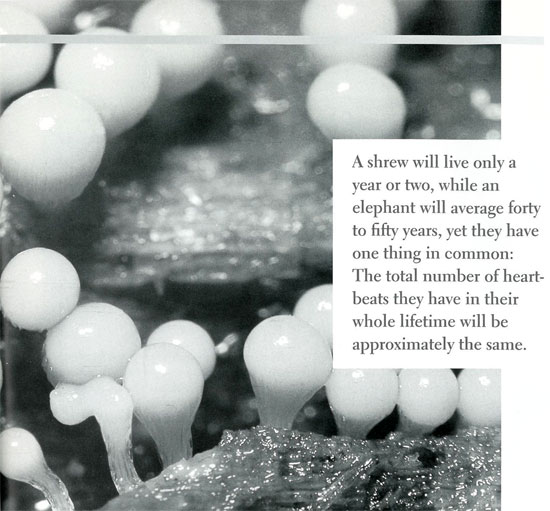As we get older we wonder at our impatience, when, as children, we had to wait in the station for the train to arrive. It is one of the many signs that time has very different meanings for us, even over our own life span. Time and life are intertwined in so many different ways, something biologists are acutely aware of. Consider a few extremes: A single-cell bacterium may live its entire life cycle in half an hour, but a generation for an elephant takes twelve years, and a giant sequoia generation takes sixty years. One reason I work with slime molds in the laboratory is that their generations are short, so that if I start an experiment on Monday, I will know the result by Wednesday or Thursday. This kind of biological time—life-cycle time—is at the middle of the time scale of living phenomena.

At the faster end of the scale is physiological time: How many beats does a heart have in a minute, or how long does it take to swerve the car to avoid a squirrel on the road? As with life cycles, these rapid living activities are greatly affected by size, so a huge elephant will have about twenty-five heartbeats per minute, while a tiny shrew’s heart goes at the amazing rate of over six hundred beats per minute. The elephant will step to one side with slow deliberation compared to a small sparrow on the window ledge with its lightning movements. We can combine the ideas of time for a life cycle and the time required for rapid physiological processes in an interesting way. A shrew will live only a year or two, while an elephant will average forty to fifty years, yet they have one thing in common: The total number of heartbeats they have in their whole lifetime will be approximately the same. So life for the small beast goes faster because its engine is racing along, compared to the larger beast, but the total budget for their actions is the same. However, their sense of time is vastly different—no wonder as small children we were impatient for the slow-moving train.
There is yet another time scale in the realm of life. It is evolutionary time. Now we are no longer dealing with one generation, but with a great series of generations going way back in time to the beginning of life on earth. We are no longer dealing with minutes or a few score of years, but with millions, even billions of years. We find in the fossil record an era when all life consisted of single cells, which later were followed by simple multicellular organisms, leading ultimately to all the great variety of animals and plants that we see on the earth today. This has been an exceedingly slow and an exceedingly grand evolution that has taken up a vast quantity of time—so much so that it is difficult to comprehend the magnitude of geological time. And we know that even these time spans are modest compared to those of the astronomer who thinks in terms of light-years.
So what does a biologist think of the second millennium? It is too short a time for much in the way of major changes in evolution, but time enough for many generations. Every one thousand years will allow some fifty human generations, but the shrew will have a new generation each year, which means a thousand each millennium. So for slime molds and shrews the second millennium has meant waiting impatiently for a huge number of generations, while it is much less of a span for elephants or ourselves.
Thank you for subscribing to Tricycle! As a nonprofit, we depend on readers like you to keep Buddhist teachings and practices widely available.